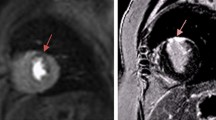Abstract
The purpose of this study was to assess the safety and indications for cardiac magnetic resonance (CMR) with myocardial perfusion imaging (MPI) in a cohort of children and young adults. A retrospective review of 178 children and young adults who underwent CMR with MPI was performed. Studies were categorized based on study protocols as MPI with resting perfusion only, adenosine stress MPI, exercise-induced stress MPI, and MPI for cardiac mass diagnosis. Relevant clinical history, exam indications, and adverse reactions following gadolinium-based contrast agent and adenosine administration were recorded. Studies were reviewed for the presence of myocardial perfusion defects, wall motion abnormalities, and delayed myocardial enhancement. The most common indications from MPI were congenital heart disease (CHD), Kawasaki disease, anomalous coronary artery, or myocardial mass characterization. Of these, 51% were protocoled with adenosine stress, 23% without stress, 6% with exercise stress, and 20% for cardiac mass evaluation. Excluding patients for myocardial mass evaluation, MPI defects were present in 16% (14 with adenosine stress, 1 with exercise stress, 8 on resting studies only). For cardiac mass evaluation, a mass was confirmed in 58%. No adverse reactions occurred with intravenous administration of a gadolinium-based contrast agent. Three self-limited adverse reactions, 2 patients with chest pain, and 1 patient with bradycardia, occurred following adenosine administration. MPI is a safe modality for the evaluation of pediatric and young adults with minimal adverse events. The most common indications for MPI were for the evaluation of CHD, Kawasaki disease, anomalous coronary artery, or myocardial mass characterization.



Similar content being viewed by others
References
Fratz S, Chung T, Greil GF et al (2013) Guidelines and protocols for cardiovascular magnetic resonance in children and adults with congenital heart disease: SCMR expert consensus group on congenital heart disease. J Cardiovasc Magn Reson 15:51. doi:10.1186/1532-429X-15-51
Ntsinjana HN, Hughes ML, Taylor AM (2011) The role of cardiovascular magnetic resonance in pediatric congenital heart disease. J Cardiovasc Magn Reson 13:51. doi:10.1186/1532-429X-13-51
Jahnke C, Nagel E, Gebker R et al (2007) Prognostic value of cardiac magnetic resonance stress tests: adenosine stress perfusion and dobutamine stress wall motion imaging. Circulation 115:1769–1776. doi:10.1161/CIRCULATIONAHA.106.652016
Bingham SE, Hachamovitch R (2011) Incremental prognostic significance of combined cardiac magnetic resonance imaging, adenosine stress perfusion, delayed enhancement, and left ventricular function over preimaging information for the prediction of adverse events. Circulation 123:1509–1518. doi:10.1161/CIRCULATIONAHA.109.907659
Beroukhim RS, Prakash A, Valsangiacomo Buechel ER et al (2011) Characterization of cardiac tumors in children by cardiovascular magnetic resonance imaging: a multicenter experience. J Am Coll Cardiol 58:1044–1054. doi:10.1016/j.jacc.2011.05.027
Buechel ERV, Balmer C, Bauersfeld U et al (2009) Feasibility of perfusion cardiovascular magnetic resonance in paediatric patients. J Cardiovasc Magn Reson 11:51. doi:10.1186/1532-429X-11-51
Prakash A, Powell AJ, Krishnamurthy R, Geva T (2004) Magnetic resonance imaging evaluation of myocardial perfusion and viability in congenital and acquired pediatric heart disease. Am J Cardiol 93:657–661. doi:10.1016/j.amjcard.2003.11.045
Taylor AM, Dymarkowski S, De Meerleer K et al (2005) Validation and application of single breath-hold cine cardiac MR for ventricular function assessment in children with congenital heart disease at rest and during adenosine stress. J Cardiovasc Magn Reson 7:743–751. doi:10.1080/10976640500283421
Manso B, Castellote A, Dos L, Casaldáliga J (2010) Myocardial perfusion magnetic resonance imaging for detecting coronary function anomalies in asymptomatic paediatric patients with a previous arterial switch operation for the transposition of great arteries. Cardiol Young 20:410–417. doi:10.1017/S1047951109990503
Coelho-Filho OR, Rickers C, Kwong RY, Jerosch-Herold M (2013) MR myocardial perfusion imaging. Radiology 266:701–715. doi:10.1148/radiol.12110918
Iskandrian AS, Heo J, Kong B, Lyons E (1989) Effect of exercise level on the ability of thallium-201 tomographic imaging in detecting coronary artery disease: analysis of 461 patients. J Am Coll Cardiol 14:1477–1486. doi:10.1016/0735-1097(89)90385-9
Voigtländer T, Schmermund A, Bramlage P et al (2011) The adverse events and hemodynamic effects of adenosine-based cardiac MRI. Korean J Radiol 12:424–430. doi:10.3348/kjr.2011.12.4.424
Karamitsos TD, Arnold JR, Pegg TJ et al (2009) Tolerance and safety of adenosine stress perfusion cardiovascular magnetic resonance imaging in patients with severe coronary artery disease. Int J Cardiovasc Imaging 25:277–283. doi:10.1007/s10554-008-9392-3
Author information
Authors and Affiliations
Corresponding author
Ethics declarations
Conflict of interest
The authors have no conflicts of interest.
Rights and permissions
About this article
Cite this article
Biko, D.M., Collins, R.T., Partington, S.L. et al. Magnetic Resonance Myocardial Perfusion Imaging: Safety and Indications in Pediatrics and Young Adults. Pediatr Cardiol 39, 275–282 (2018). https://doi.org/10.1007/s00246-017-1752-0
Received:
Accepted:
Published:
Issue Date:
DOI: https://doi.org/10.1007/s00246-017-1752-0




